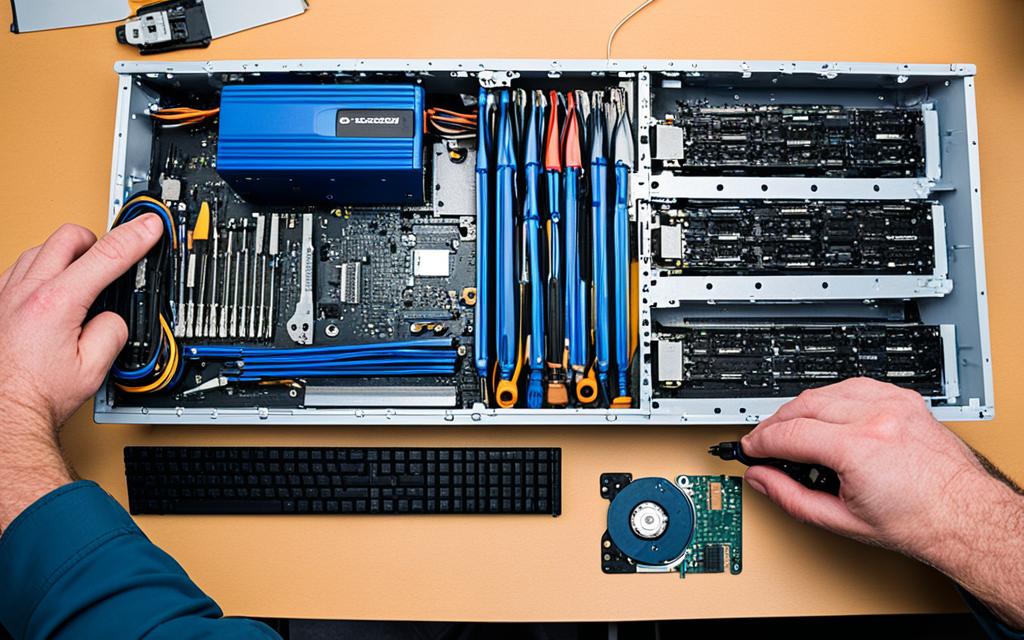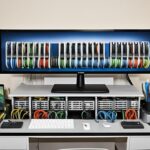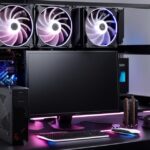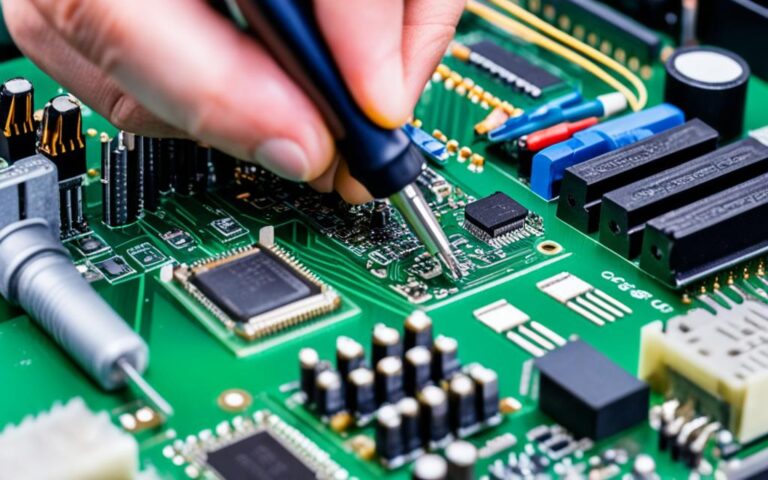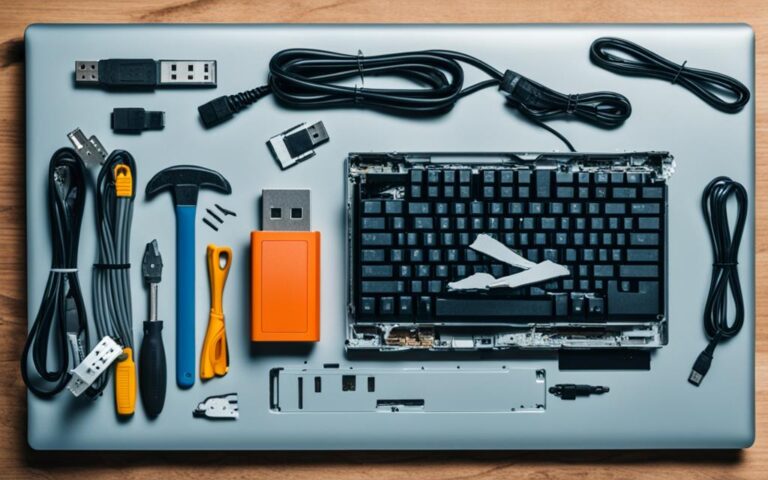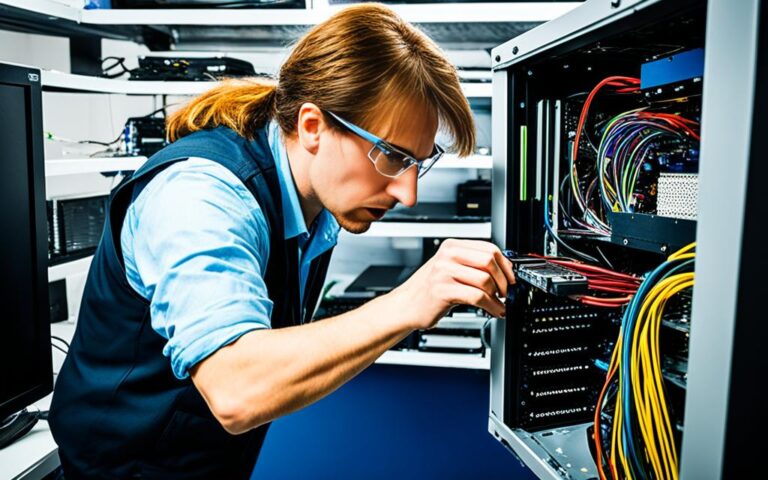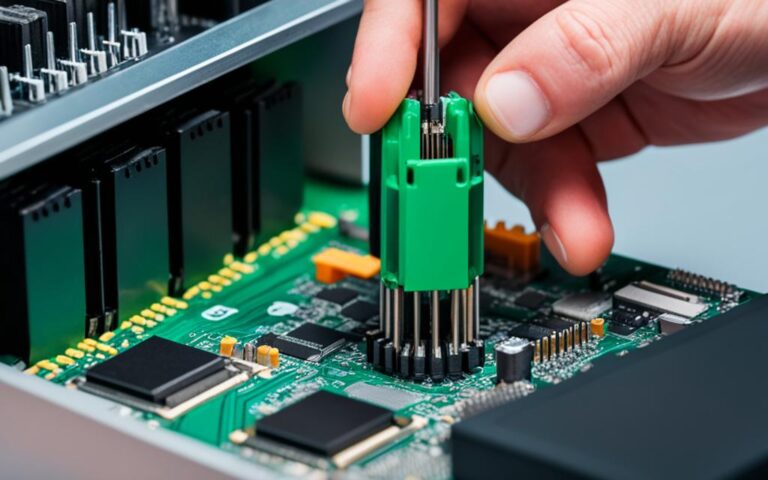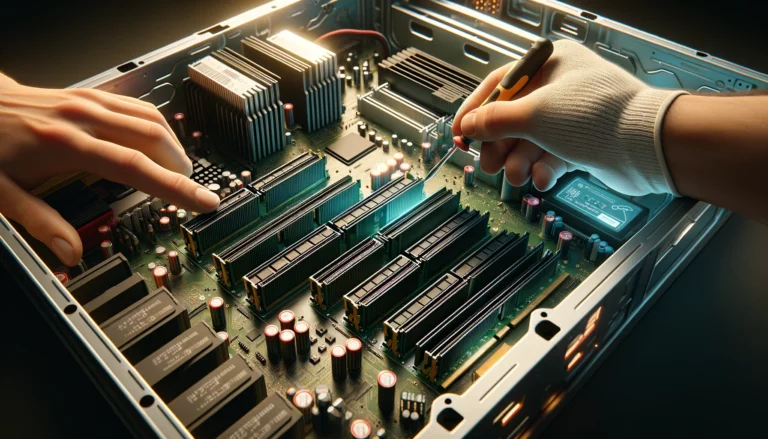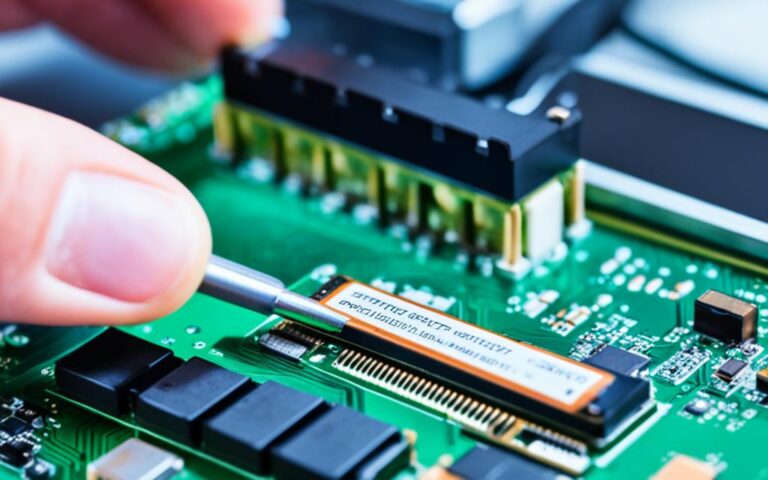Replacing and Upgrading Desktop Hard Drives
If you’re looking to improve your PC’s performance and increase its storage capacity, one of the most effective ways is by replacing or upgrading the hard drive. By doing so, you can enjoy faster speeds and more storage space to accommodate your growing needs.
Whether you’re considering a switch to a solid state drive (SSD) for improved performance or prefer a traditional hard drive for its affordability, this guide will help you make the right decision and ensure a smooth installation process.
Hard drive upgrades offer numerous benefits, from enhanced speed to increased storage capacity, giving your PC a new lease on life. With the right knowledge and guidance, you can easily replace or upgrade your desktop hard drive and enjoy a faster and more spacious system. Let’s dive in and explore the options!
Choosing Between a Hard Drive and an SSD
When considering a new drive, you’ll be faced with the decision of choosing between a solid-state drive (SSD) or a traditional hard drive (HDD). Both options have their own advantages and considerations, so it’s important to weigh your needs and priorities before making a decision.
Speed vs. Storage:
SSDs are known for their lightning-fast speeds and improved performance. With no moving parts, they can access and retrieve data much faster than HDDs. This makes SSDs an excellent choice for those who value speed and want to enjoy faster boot times, quicker file transfers, and a more responsive overall experience.
On the other hand, HDDs offer larger storage capacities at a more affordable price point. If you require a significant amount of storage space for your files, media, or projects, an HDD might be the better option. They provide ample storage for large collections of photos, videos, and documents without breaking the bank.
It’s worth noting that SSDs have become more accessible in recent years, with prices gradually dropping and capacities increasing. This makes it easier to strike a balance between speed and storage, and SSDs are increasingly becoming the go-to choice for many users.
Solid State Drives:
SSDs are built using flash memory, which allows them to read and write data at incredibly high speeds. These drives are available in various form factors, including 2.5-inch drives that are commonly used in laptops and smaller form factors like M.2 drives, which are ideal for ultra-thin notebooks and other compact devices. They are highly reliable and durable, with no moving parts that can fail or break.
Traditional Hard Drives:
Traditional HDDs, on the other hand, rely on spinning magnetic disks and mechanical components to store and retrieve data. They have been the default storage solution for years and can still offer excellent performance for tasks that don’t require high-speed data access. HDDs come in various sizes, with 3.5-inch drives being the most common for desktop computers and 2.5-inch drives typically used in laptops.
Summary:
| SSD | HDD |
|---|---|
| ✓ Faster speeds and improved performance | ✓ Larger storage capacities at a more affordable price |
| ✓ Ideal for speed-focused users | ✓ Great for users with large storage needs on a budget |
| ✓ Flash memory technology and no moving parts | ✓ Relies on spinning disks and mechanical components |
Ultimately, the choice between an SSD and HDD boils down to your specific needs and budget. If blazing-fast speeds are a priority, or if you want to enjoy the benefits of flash memory technology, an SSD is the way to go. However, if cost-effectiveness and high storage capacities are more important, an HDD might be the better fit for your requirements.
Selecting the Right Size and Form Factor
When it comes to hard drives, size matters. Different devices require different sizes and form factors to ensure compatibility and optimal performance. Let’s take a closer look at the most common options and their suitability for desktop and laptop computers.
2.5-Inch Hard Drives
2.5-inch hard drives are typically used in laptops and smaller form factor devices due to their compact size. These drives offer a balance between storage capacity and portability, making them ideal for those who require storage on the go. Most laptops are compatible with 2.5-inch drives, so upgrading your laptop’s storage is usually a straightforward process.
3.5-Inch Hard Drives
For desktop computers, 3.5-inch hard drives are the most commonly used form factor. These larger drives provide higher storage capacities and are generally more cost-effective than their smaller counterparts. If you’re upgrading or replacing the hard drive in your desktop PC, a 3.5-inch drive is likely the best choice for you.
M.2 Drives
In recent years, M.2 drives have gained popularity due to their compact size and high-speed capabilities. These drives are often used in both desktops and laptops that support the M.2 form factor. M.2 drives offer superior performance and can significantly improve system responsiveness, making them an excellent choice for users who require faster data transfer speeds.
To ensure compatibility, check your computer’s specifications and motherboard documentation to identify the supported size and form factor. Many modern motherboards are equipped with M.2 slots, but it’s essential to verify this before purchasing an M.2 drive for your system.
| Drive | Size | Form Factor | Compatibility |
|---|---|---|---|
| 2.5-Inch Hard Drive | 2.5 inches | Standard | Laptops and some desktops |
| 3.5-Inch Hard Drive | 3.5 inches | Standard | Desktops |
| M.2 Drive | Varies | M.2 | Select desktops and laptops |
Remember to choose the right size and form factor that aligns with your device’s requirements. Whether you’re upgrading a laptop or desktop, selecting the appropriate hard drive size and form factor is crucial for a successful installation and optimal performance.
Understanding the Connection Requirements
All modern hard drives use a SATA connection for both power and data transfer. This SATA connection ensures efficient and reliable communication between the hard drive and the rest of the computer system. It is essential to understand the various connection requirements when replacing or upgrading your desktop hard drive.
For desktop PCs, two primary types of cables are involved in the SATA connection: the power cable and the data cable. The SATA power cable connects the hard drive to the power supply, providing it with the necessary electrical power. On the other hand, the SATA data cable connects the hard drive to the motherboard, facilitating the transfer of data between the two components.
It’s important to note that laptops often have an internal slot for the hard drive, which comes with pre-connected power and data cables. Therefore, the process of replacing the hard drive in a laptop is generally more straightforward.
When selecting a new hard drive, make sure it is compatible with your PC’s SATA revision, which determines the maximum data transfer rate. The SATA revision is indicated by a number, such as SATA 2 or SATA 3, with each subsequent revision offering faster speeds. Check your computer’s documentation or consult the manufacturer’s website to find out the SATA revision supported by your system.
Ensuring the compatibility between the chosen hard drive, power cable, data cable, and SATA revision is crucial for optimal performance and seamless integration into your system.
The SATA Connection
The SATA (Serial Advanced Technology Attachment) connection is a standard interface used in modern computer systems for connecting hard drives, solid-state drives, and optical drives. It has largely replaced the older IDE (Integrated Drive Electronics) connection due to its superior speed and performance.
| SATA Version | Maximum Data Transfer Rate | Commonly Used |
|---|---|---|
| SATA 1 | 1.5 Gbit/s | No |
| SATA 2 | 3 Gbit/s | No |
| SATA 3 | 6 Gbit/s | Yes |
The SATA 3 revision, commonly referred to as SATA III, is the most widely used and offers the highest data transfer rate of 6 Gbit/s. However, it’s essential to ensure that your computer’s motherboard supports the chosen SATA revision. Older systems may only support SATA 1 or 2, limiting the potential speed of your hard drive.
Before installing a new hard drive, check your PC’s documentation or consult the manufacturer’s website to determine the supported SATA revision and choose a compatible drive accordingly.
Power and Data Cables
Desktop PCs require both a SATA power cable and a SATA data cable for the hard drive’s proper functioning. The SATA power cable connects to the power supply unit (PSU) and provides the necessary electrical power to the drive, ensuring it can spin up and operate correctly.
Meanwhile, the SATA data cable connects the hard drive to the motherboard, allowing for the transfer of data between the two components. Most modern motherboards feature multiple SATA ports, accommodating multiple hard drives and other SATA devices.
When selecting a new hard drive, ensure that both the power cable and the data cable are compatible with the drive and your computer’s connections. SATA cables come in various lengths, so choose the appropriate length to reach your hard drive without strain or excessive cable clutter.
Estimating the Storage and Speed Requirements
Before replacing or upgrading your hard drive, it’s important to estimate the storage capacity and speed requirements for your new drive. Consider your specific needs, whether you prioritize storage space or speed, and explore different options to make an informed decision. By understanding the key factors such as storage capacity, revolutions per minute (RPM), hybrid drives, and file caching, you can choose a drive that best suits your requirements.
Determining Storage Capacity
One of the primary considerations when selecting a new hard drive is the storage capacity. Assess your storage needs by considering the types of files you typically work with and the amount of space they require. If you frequently deal with large media files, such as high-resolution images or videos, you may need a drive with a higher storage capacity.
Traditional hard drives offer a range of storage capacities to accommodate different needs. When comparing options, consider the RPM of the drive as well, as it can impact the speed at which data is accessed and transferred.
Understanding RPM and Hybrid Drives
Traditional hard drives are typically measured in revolutions per minute (RPM) and offer various options, such as 5400 RPM, 7200 RPM, or high-performance 10,000 RPM drives. Higher RPM drives tend to provide faster data access and transfer speeds, which can result in improved overall system performance.
On the other hand, hybrid drives combine the best of both worlds by integrating traditional hard drives with flash storage. This combination allows for quicker access to frequently accessed files through file caching, resulting in faster performance.
| Drive Type | Storage Capacity | RPM | Performance |
|---|---|---|---|
| Traditional Hard Drive | Varied options | 5400, 7200, or 10,000 | Depends on RPM |
| Hybrid Drive | Varied options | Combines traditional HDD with flash storage | Improved performance through file caching |
Considering File Caching
File caching is a technique used by hybrid drives and some other storage solutions to improve performance. It involves storing frequently accessed files in a temporary cache, allowing for faster access and retrieval. This can significantly enhance the overall speed and responsiveness of your system, particularly when dealing with files or applications that are frequently used.
By considering the benefits of file caching and understanding how it can impact performance, you can determine whether a hybrid drive or another storage solution that utilizes file caching is right for your needs.
By carefully considering the storage capacity, RPM, hybrid drives, and file caching options, you can make an informed decision when selecting a new hard drive. Assess your specific requirements, explore different options, and choose a drive that provides the optimal balance between storage space and speed. This will ensure that your upgraded system meets your needs and delivers the performance you desire.
Transferring vs. Clean Installation of the Operating System
Before installing the new drive, you’ll need to decide whether to transfer your operating system and data from the old drive or perform a clean installation. Both options have their pros and cons, so it’s important to consider your specific needs and preferences.
The Transfer Process
Transferring the operating system involves backing up your data, using the tools provided with the new drive, and following a slow and intricate process. While this method allows you to retain all your programs, settings, and files, it can be time-consuming and may require technical expertise.
“Transferring the operating system requires attention to detail and careful execution. Ensure you have a backup of your important files and follow the instructions provided by the drive manufacturer to ensure a successful transfer.”
In most cases, the transfer process can be done using specialized software tools provided with the new drive. These tools typically guide you through the process, assisting with data migration and ensuring the integrity of your operating system. However, it’s crucial to exercise caution and follow the instructions meticulously to avoid data loss or system errors.
The Clean Installation Approach
On the other hand, a clean installation offers a fresh start by wiping your old drive completely and installing the operating system from scratch. This method provides a clean slate, eliminating any potential issues or system clutter that may have accumulated over time. However, it requires reinstalling all your programs and restoring your files from a backup or external storage.
“A clean installation is a great opportunity to optimize your system by starting fresh. Remember to back up your files beforehand and have the necessary installation media or recovery disc available.”
To perform a clean installation, you’ll need to back up your data, create a bootable installation media (such as a USB drive or DVD), and follow the installation prompts. Once the operating system is installed, you can then proceed to reinstall your programs and restore your files from backup or external storage.
Choosing the Right Option for You
Deciding between transferring the operating system and performing a clean installation depends on your individual circumstances and preferences. If you have limited technical knowledge or want to retain your programs and files without the hassle of reinstalling everything, transferring the operating system may be the better choice.
However, if you’re looking for a fresh start and don’t mind reinstalling your programs and restoring your files, a clean installation can provide a more optimized and streamlined system.
Whatever option you choose, ensuring you have a reliable backup of your data is essential to protect against data loss during the process.
Now that you understand the differences between transferring the operating system and performing a clean installation, you can make an informed decision that best suits your needs.
Step-by-Step Guide to Replacing the Hard Drive
Replacing the hard drive in a desktop computer may seem like a daunting task, but with the right guidance, it can be a smooth and successful process. Follow this step-by-step guide to ensure a successful hard drive replacement.
1. Backing up Data
Before starting the replacement process, it is crucial to back up all your important data. This ensures that you don’t lose any valuable information during the transition. Save your files to an external hard drive, cloud storage, or another computer so that you can easily restore them later.
2. Removing the Old Drive
First, shut down your computer and unplug it from the power source. Open up the computer case and locate the old hard drive. Disconnect any cables attached to it, including the power and data cables. Gently remove the old drive from the mounting bracket or cage, taking care not to damage any other components.
3. Installing the New Drive
Place the new hard drive into the mounting bracket or cage, ensuring that it is securely positioned. Connect the necessary cables to the new drive, including the power and data cables. Ensure that the cables are properly aligned and securely connected.
4. Formatting the Drive
Once the new drive is installed, you will need to format it before use. Formatting prepares the drive for data storage and ensures compatibility with your operating system. Follow the instructions provided by your operating system to format the new drive.
5. OS Reinstallation
After formatting the new drive, you will need to reinstall your operating system. This process may vary depending on the operating system you are using. Follow the instructions provided by your operating system to reinstall the OS, ensuring that you select the newly installed drive as the destination for the operating system.
After completing these steps, your new hard drive should be successfully installed and ready for use. Remember to restore your backed-up data to the new drive and test its functionality. Enjoy the increased storage capacity and improved performance of your upgraded hard drive!
| Step | Description |
|---|---|
| 1 | Backing up Data |
| 2 | Removing the Old Drive |
| 3 | Installing the New Drive |
| 4 | Formatting the Drive |
| 5 | OS Reinstallation |
Conclusion
Upgrading or replacing the hard drive in your desktop computer can have a significant impact on its performance and storage capacity. By carefully considering your needs and budget, you can make an informed decision between an SSD and HDD, ensuring compatibility with your PC’s size and form factor. Following our step-by-step guide, you can confidently replace the hard drive and choose between transferring the operating system or performing a clean installation.
With your new hard drive, you’ll experience the benefits of a faster and more spacious system. An SSD offers faster speeds and improved performance, perfect for those who prioritize speed, while an HDD provides larger storage capacities at a more affordable price. Remember to back up your data before making any changes and take the necessary precautions to ensure a successful hard drive replacement.
In summary, upgrading your desktop’s hard drive can be a game-changer for your computer’s performance and storage capacity. Evaluate your requirements, select the appropriate drive, and follow our comprehensive guide for a smooth replacement process. Whether you choose a solid state drive or a traditional hard drive, you’ll enjoy a faster and more spacious system that meets your specific needs.
